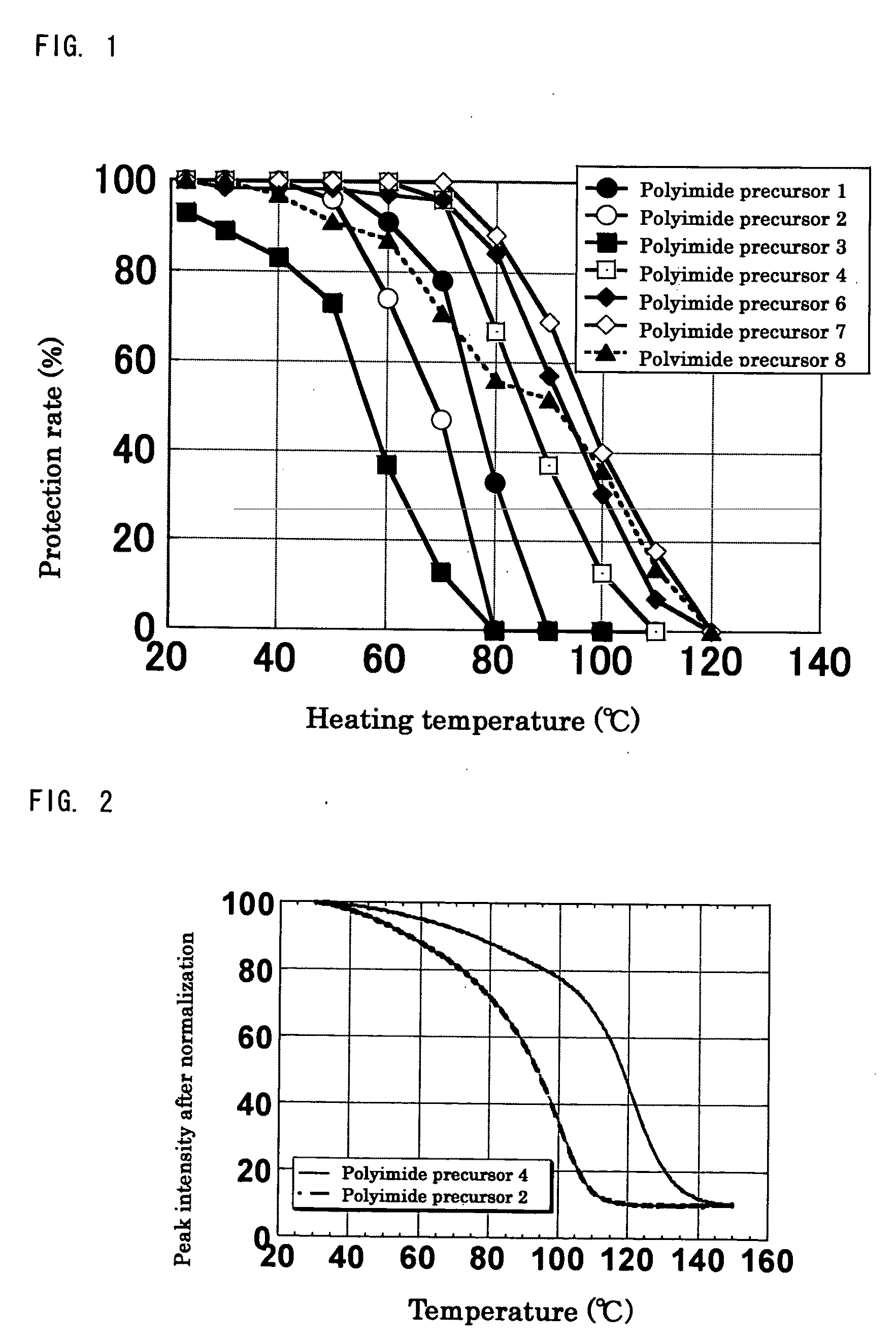Polyimide precursor, resin composition comprising the polyimide precursor, pattern forming method using the resin composition, and articles produced by using the resin composition
a technology of polyimide precursor and resin composition, which is applied in the direction of photosensitive materials, instruments, photomechanical equipment, etc., can solve the problems of poor chemical resistance or adhesion of polyimide to a substrate, decrease in molecular weight, and inability to withstand heat or water, and achieve excellent chemical resistance or adhesion to the polyimide substrate, easy to synthesize, and low cost
- Summary
- Abstract
- Description
- Claims
- Application Information
AI Technical Summary
Benefits of technology
Problems solved by technology
Method used
Image
Examples
production example 1
[0248]After a 100 ml three-neck flask was heated under nitrogen flow to be dried sufficiently, 0.99 g of a white solid substance of BPDA-ODA (a polyamic acid made of 3,3,4,4-biphenyltetracarboxylic dianhydride and 4,4′-diaminodiphenyl ether; number average molecular weight obtained from NMR of 12,000), which was obtained by polymerizing with a dimethylacetamide solvent followed by refining by reprecipitation with acetone and drying a precipitate obtained, 5 g of n-butyl vinyl ether (n-BVE), and 5 ml of dried γ-butyrolactone were charged in the flask with careful attention to moisture in the air. Stirring was performed with a magnetic stirrer for 112 hours under dried nitrogen flow at room temperature. BPDA-ODA did not dissolve in the beginning but dissolved with progression of the reaction, and became a brown liquid. Then, a half amount of the reaction liquid was reprecipitated with dried diethyl ether. Thus, a white solid substance of BPDA-ODA protected by n-butyl vinyl ether (poly...
production examples 2 to 5
[0249]Synthesis was performed in the similar conditions as Production example 1 except that n-butyl vinyl ether was changed to different vinyl ether compounds shown in Table 1. In all experiments, white solid substances of polyimide precursors 2 to 5 having a protection rate of 100% was obtained quantitatively without gelation. As for polyimide precursor 5, the ratio of protective groups of n-BVE and VEEA (n-BVE:VEEA) was 65:35 from the integrated ratio obtained by 1H-NMR.
TABLE 1ReactionVinyl ether compoundtimeProductionPolyimideCyclohexylCVE 88 hrsexample 2precursor 2vinyl etherProductionPolyimidet-Butyl vinylt-BVE 48 hrsexample 3precursor 3etherProductionPolyimideEthylene glycolEGBVE112 hrsexample 4precursor 4butyl vinyletherProductionPolyimideA mixedn-BVE:VEEA =112 hrsexample 5precursor 5compound of65:35n-butyl vinylether andVEEA bymolar ratioof 65:35
production example 6
[0250]Synthesis was performed in the similar conditions as Production example 1 except that 3,4-dihydro-2H-pyrane (DHP) was used instead of n-butyl vinyl ether, and the reaction time was 240 hours. In the experiment, gelation did not occur, and a white solid substance of polyimide precursor 6 was obtained. Similarly as Production example 1, through analysis of 1H-NMR, it was confirmed that the protection rate (the reactivity of hemiacetal ester bonds to carboxyl groups) of Production example 6 was 100%.
PUM
| Property | Measurement | Unit |
|---|---|---|
| boiling point | aaaaa | aaaaa |
| temperature | aaaaa | aaaaa |
| wavelength | aaaaa | aaaaa |
Abstract
Description
Claims
Application Information
 Login to View More
Login to View More - R&D
- Intellectual Property
- Life Sciences
- Materials
- Tech Scout
- Unparalleled Data Quality
- Higher Quality Content
- 60% Fewer Hallucinations
Browse by: Latest US Patents, China's latest patents, Technical Efficacy Thesaurus, Application Domain, Technology Topic, Popular Technical Reports.
© 2025 PatSnap. All rights reserved.Legal|Privacy policy|Modern Slavery Act Transparency Statement|Sitemap|About US| Contact US: help@patsnap.com



